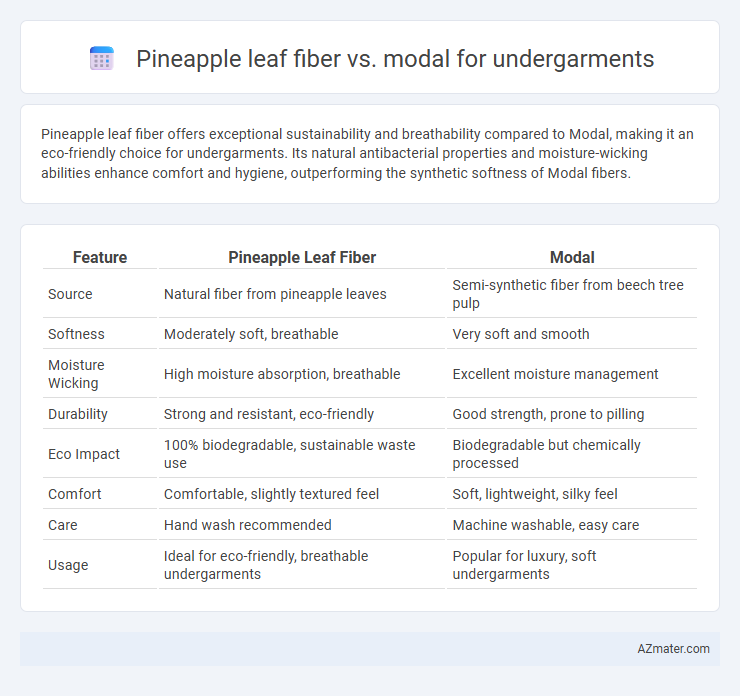Pineapple leaf fiber offers exceptional sustainability and breathability compared to Modal, making it an eco-friendly choice for undergarments. Its natural antibacterial properties and moisture-wicking abilities enhance comfort and hygiene, outperforming the synthetic softness of Modal fibers.
Table of Comparison
| Feature | Pineapple Leaf Fiber | Modal |
|---|---|---|
| Source | Natural fiber from pineapple leaves | Semi-synthetic fiber from beech tree pulp |
| Softness | Moderately soft, breathable | Very soft and smooth |
| Moisture Wicking | High moisture absorption, breathable | Excellent moisture management |
| Durability | Strong and resistant, eco-friendly | Good strength, prone to pilling |
| Eco Impact | 100% biodegradable, sustainable waste use | Biodegradable but chemically processed |
| Comfort | Comfortable, slightly textured feel | Soft, lightweight, silky feel |
| Care | Hand wash recommended | Machine washable, easy care |
| Usage | Ideal for eco-friendly, breathable undergarments | Popular for luxury, soft undergarments |
Introduction to Sustainable Undergarment Fabrics
Pineapple leaf fiber, derived from agricultural waste, offers a biodegradable and eco-friendly alternative to conventional fabrics used in undergarments, promoting sustainability through natural renewability and low chemical processing. Modal, a semi-synthetic fabric made from beech tree cellulose, provides exceptional softness and breathability but involves more intensive chemical treatment, raising concerns about environmental impact despite its biodegradability. Choosing pineapple leaf fiber fibers supports circular fashion by reducing waste and conserving resources, while modal emphasizes comfort and durability within the realm of sustainable fabric innovation.
What is Pineapple Leaf Fiber?
Pineapple leaf fiber, derived from the leaves of the pineapple plant, is a natural, sustainable textile known for its strength, breathability, and biodegradability, making it an eco-friendly alternative for undergarment production. This fiber offers moisture-wicking and antibacterial properties, enhancing comfort and hygiene in intimate apparel. Compared to modal, which is a semi-synthetic fiber made from beech tree pulp, pineapple leaf fiber supports environmental sustainability by using agricultural waste and requiring less chemical processing.
Understanding Modal Fabric
Modal fabric, derived from beech tree pulp, is known for its exceptional softness, breathability, and moisture-wicking properties, making it ideal for undergarments. Compared to pineapple leaf fiber, Modal offers a smoother texture and better elasticity, enhancing comfort and fit in intimate apparel. Its ability to retain color and resist shrinkage ensures durability, while being more environmentally sustainable than conventional synthetic fibers.
Environmental Impact: Pineapple Leaf Fiber vs Modal
Pineapple leaf fiber offers a significantly lower environmental footprint compared to modal, as it is derived from agricultural waste without requiring deforestation, chemical-intensive processes, or high water consumption. Modal production involves heavy use of chemicals and extensive water resources, contributing to pollution and higher carbon emissions. Choosing pineapple leaf fiber for undergarments supports sustainable manufacturing practices by utilizing renewable resources and minimizing ecological damage.
Comfort and Softness Comparison
Pineapple leaf fiber offers a unique texture with moderate softness and breathability, making it eco-friendly but less smooth compared to Modal, which excels in producing exceptionally soft, silky fabrics ideal for sensitive skin in undergarments. Modal fibers absorb moisture efficiently, enhancing comfort during prolonged wear, whereas pineapple leaf fiber tends to retain a slightly coarser feel, impacting its immediate softness but providing natural durability. Consumers seeking plush comfort and luxurious softness typically prefer Modal, while those prioritizing sustainability and natural fiber content may opt for pineapple leaf fiber undergarments.
Moisture Absorption and Breathability
Pineapple leaf fiber excels in moisture absorption due to its natural hydrophilic properties, effectively wicking sweat away from the skin and enhancing comfort in undergarments. Modal, a semi-synthetic fiber derived from beech tree pulp, offers superior breathability by allowing air circulation while maintaining softness and durability. Combining pineapple leaf fiber with modal can create undergarments that balance excellent moisture management and ventilation, ideal for activewear and everyday comfort.
Durability and Longevity
Pineapple leaf fiber offers exceptional durability and strength, making it highly resistant to wear and tear in undergarments compared to Modal, which tends to have a softer feel but lower tensile strength. Undergarments made from pineapple leaf fiber maintain their structural integrity and shape over extended use, ensuring longer-lasting performance. Modal fibers, though comfortable and moisture-wicking, generally degrade faster under frequent washing and stretching, reducing overall longevity.
Skin-Friendliness and Hypoallergenic Properties
Pineapple leaf fiber exhibits excellent skin-friendliness due to its natural breathability and moisture-wicking properties, making it ideal for sensitive skin in undergarments. Modal, derived from beech tree pulp, is highly regarded for its smooth texture and hypoallergenic features, reducing irritation and allergic reactions. Both fibers offer sustainable options, but pineapple leaf fiber provides enhanced antibacterial benefits, contributing to improved comfort and skin health.
Aesthetic and Design Possibilities
Pineapple leaf fiber offers a natural, textured aesthetic with a subtle sheen that enhances unique, eco-friendly designs, while Modal provides a smooth, silky finish ideal for sleek, modern undergarments. The inherent stiffness of pineapple leaf fiber supports structured, innovative silhouettes, contrasting Modal's fluidity that allows for draping and seamless tailoring. Designers leverage pineapple leaf fiber for sustainability-focused collections emphasizing raw beauty, whereas Modal excels in luxury and comfort with vibrant colors and prints.
Cost and Market Availability
Pineapple leaf fiber offers a sustainable and eco-friendly alternative for undergarments but generally comes at a higher production cost due to limited processing infrastructure and lower industrial scale compared to modal. Modal, a semi-synthetic fiber derived from beech tree cellulose, benefits from widespread manufacturing networks and mature supply chains, making it more cost-effective and readily available in the global textile market. Market availability of pineapple leaf fiber remains niche and regional, predominantly in countries like the Philippines and Thailand, whereas modal enjoys extensive international distribution and established commercial use in undergarment production.

Infographic: Pineapple leaf fiber vs Modal for Undergarment
 azmater.com
azmater.com